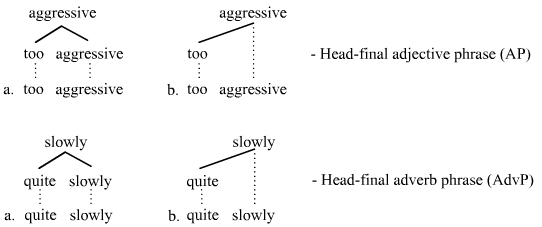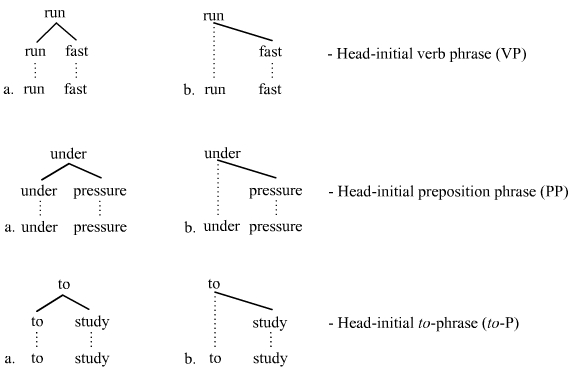268:(A). In the constituency trees on the left, the noun projects its category status up to the mother node, so that the entire phrase is identified as a noun phrase (NP). In the dependency trees on the right, the noun projects only a single node, whereby this node dominates the one node that the adjective projects, a situation that also identifies the entirety as an NP. The constituency trees are structurally the same as their dependency counterparts, the only difference being that a different convention is used for marking heads and dependents. The conventions illustrated with these trees are just a couple of the various tools that grammarians employ to identify heads and dependents. While other conventions abound, they are usually similar to the ones illustrated here.
433:
writing) from left to right. Most dependencies have the head preceding its dependent(s), although there are also head-final dependencies in the tree. For instance, the determiner-noun and adjective-noun dependencies are head-final as well as the subject-verb dependencies. Most other dependencies in
English are, however, head-initial as the tree shows. The mixed nature of head-initial and head-final structures is common across languages. In fact purely head-initial or purely head-final languages probably do not exist, although there are some languages that approach purity in this respect, for instance Japanese.
432:
The tree shows the extent to which
English is primarily a head-initial language. On the broadest level, the verb phrase "discovered that he had been changed into a monstrous verminous bug" begins with the verb headword "discovered". Structure is descending as speech and processing move (visually in
276:
The four trees above show a head-final structure. The following trees illustrate head-final structures further as well as head-initial and head-medial structures. The constituency trees (= a-trees) appear on the left, and dependency trees (= b-trees) on the right. Henceforth the convention is
537:, the head is the part that extends from the first stressed syllable up to (but not including) the tonic syllable. A high head is the stressed syllable that begins the head and is high in pitch, usually higher than the beginning pitch of the tone on the tonic syllable. For example:
450:
A large majority of head-dependent orderings in
Japanese are head-final. This fact is obvious in this tree, since structure is strongly ascending as speech and processing move from left to right. Thus the word order of Japanese is in a sense the opposite of English.
619:
Discerning heads from dependents is not always easy. The exact criteria that one employs to identify the head of a phrase vary, and definitions of "head" have been debated in detail. See the exchange between Zwicky (1985, 1993) and Hudson (1987) in this
377:
This structure is both head-initial and head-final, which makes it head-medial in a sense. It is head-initial insofar as the head X precedes its complement, but it is head-final insofar as the projection X' of the head follows its specifier.
424:
471:. A given dependency is head-marking, if something about the dependent influences the form of the head, and a given dependency is dependent-marking, if something about the head influences the form of the dependent.
259:
The constituency relation is shown on the left and the dependency relation on the right. The a-trees identify heads by way of category labels, whereas the b-trees use the words themselves as the labels. The noun
327:
445:
307:
287:
249:
367:
406:(= left-branching), assuming that it has a fixed word order at all. English is more head-initial than head-final, as illustrated with the following dependency tree of the first sentence of
610:
For a good general discussion of heads, see Miller (2011:41ff.). However, take note Miller miscites Hudson's (1990) listing of Zwicky's criteria of headhood as if these were
Matthews'.
357:
also acknowledge head-initial, head-final, and head-medial phrases, although the depiction of heads is less direct. The standard X-bar schema for
English is as follows:
223:
Many theories of syntax represent heads by means of tree structures. These trees tend to be organized in terms of one of two relations: either in terms of the
337:
The head-medial constituency trees here assume a more traditional n-ary branching analysis. Since some prominent phrase structure grammars (e.g. most work in
437:
543:
A low head is the syllable that begins the head and is low in pitch, usually lower than the beginning pitch of the tone on the tonic syllable.
109:. Head-initial phrases are right-branching, head-final phrases are left-branching, and head-medial phrases combine left- and right-branching.
277:
employed where the words appear as the labels on the nodes. The next four trees are additional examples of head-final phrases:
571:
629:
Dependency grammar trees similar to the ones produced in this article can be found, for instance, in Ágel et al. (2003/6).
105:("headless") phrases and compounds (if they exist) lack a clear head. Heads are crucial to establishing the direction of
436:
The following tree is of the same sentence from Kafka's story. The glossing conventions are those established by
667:
Corbett, G., N. Fraser, and S. McGlashan (eds). 1993. Heads in
Grammatical Theory. Cambridge University Press.
576:
391:
338:
700:
638:
Using the words themselves as the labels on the nodes in trees is a convention that is consistent with
468:
423:
561:
203:
17:
591:
460:
228:
77:
that determines the semantic category of that compound. For example, the head of the compound noun
556:
106:
326:
70:
581:
464:
444:
306:
286:
248:
86:
8:
91:
566:
486:
342:
236:
686:
Zwicky, A. 1993. Heads, bases and functors. In G. Corbett, et al. (eds) 1993, 292–315.
412:
366:
202:
is the head in this compound. The heads of phrases can often be identified by way of
85:, since a handbag is a bag, not a hand. The other elements of the phrase or compound
345:) take all branching to be binary, these head-medial a-trees may be controversial.
159:
680:
Nichols, J. 1986. Head-marking and dependent-marking grammar. Language 62, 56-119.
664:
Chomsky, N. 1995. The
Minimalist Program. Cambridge, Massachusetts: The MIT Press.
674:
475:
694:
534:
182:
is the head since it determines the basic meaning of the compound. The stem
354:
407:
155:
51:
31:
670:
Hudson, R. A. 1987. Zwicky on heads. Journal of
Linguistics 23, 109–132.
395:
101:
210:
requires the substitute to be a noun (or pronoun), not an adjective.
74:
206:. For instance, substituting a single word in place of the phrase
683:
Zwicky, A. 1985. Heads. Journal of
Linguistics 21, pp. 1–29.
440:. One can easily see the extent to which Japanese is head-final:
317:
And the following six trees are examples of head-medial phrases:
586:
387:
47:
43:
239:. Both relations are illustrated with the following trees:
58:
297:
The following six trees illustrate head-initial phrases:
381:
485:) appears on the dependent (the possessor), whereas in
50:
category of that phrase. For example, the head of the
454:
194:
is a kind of song, not a kind of bird. Conversely, a
186:
modifies this meaning and is therefore dependent on
692:
489:possessive marking appears on the head noun:
386:Some language typologists classify language
95:. Headed phrases and compounds are called
154:since it determines that the phrase is a
459:It is also common to classify language
89:the head, and are therefore the head's
14:
693:
382:Head-initial vs. head-final languages
213:
572:Head-driven phrase structure grammar
170:modify this head noun, they are its
27:Primary part of a grammatical phrase
264:(N) is the head over the adjective
117:Examine the following expressions:
24:
455:Head-marking vs. dependent-marking
174:. Similarly, in the compound noun
25:
712:
675:A critical introduction to syntax
463:according to whether a phrase is
198:is a type of bird since the stem
112:
528:
443:
422:
365:
325:
305:
285:
247:
46:is the word that determines the
398:, that is, whether a phrase is
645:
632:
623:
613:
604:
348:
13:
1:
657:
577:Head directionality parameter
474:For instance, in the English
392:head directionality parameter
339:Government and binding theory
271:
69:. Analogously, the head of a
353:Trees that are based on the
7:
549:
522:(the man house-POSSESSIVE)
10:
717:
642:(BPS). See Chomsky (1995).
229:phrase structure grammars
162:. Because the adjectives
598:
592:Phrase structure grammar
494:
218:
402:(= right-branching) or
478:, possessive marking (
640:bare phrase structure
582:Head-marking language
677:. London: Continuum.
651:See Nichols (1986).
237:dependency grammars
701:Syntactic entities
567:Dependency grammar
546:The bus was late.
540:The bus was late.
343:Minimalist Program
214:Representing heads
204:constituency tests
673:Miller, J. 2011.
526:
525:
469:dependent-marking
413:The Metamorphosis
55:boiling hot water
16:(Redirected from
708:
652:
649:
643:
636:
630:
627:
621:
617:
611:
608:
492:
491:
482:
447:
426:
369:
329:
309:
289:
251:
160:adjective phrase
21:
716:
715:
711:
710:
709:
707:
706:
705:
691:
690:
689:
660:
655:
650:
646:
637:
633:
628:
624:
618:
614:
609:
605:
601:
596:
552:
531:
480:
476:possessive case
457:
390:according to a
384:
351:
274:
221:
216:
115:
28:
23:
22:
15:
12:
11:
5:
714:
704:
703:
688:
687:
684:
681:
678:
671:
668:
665:
661:
659:
656:
654:
653:
644:
631:
622:
612:
602:
600:
597:
595:
594:
589:
584:
579:
574:
569:
564:
559:
553:
551:
548:
530:
527:
524:
523:
514:
511:
508:
507:
498:
495:
456:
453:
430:
429:
428:
427:
383:
380:
375:
374:
373:
372:
371:
370:
350:
347:
335:
334:
333:
332:
331:
330:
315:
314:
313:
312:
311:
310:
295:
294:
293:
292:
291:
290:
273:
270:
257:
256:
255:
254:
253:
252:
220:
217:
215:
212:
140:
139:
138:
137:
136:
135:
129:
114:
113:Basic examples
111:
26:
9:
6:
4:
3:
2:
713:
702:
699:
698:
696:
685:
682:
679:
676:
672:
669:
666:
663:
662:
648:
641:
635:
626:
616:
607:
603:
593:
590:
588:
585:
583:
580:
578:
575:
573:
570:
568:
565:
563:
560:
558:
555:
554:
547:
544:
541:
538:
536:
535:prosodic unit
529:Prosodic head
521:
520:
515:
512:
510:
509:
506:
504:
499:
496:
493:
490:
488:
484:
477:
472:
470:
466:
462:
452:
448:
446:
441:
439:
434:
425:
421:
420:
419:
418:
417:
415:
414:
409:
405:
401:
397:
393:
389:
379:
368:
364:
363:
362:
361:
360:
359:
358:
356:
346:
344:
340:
328:
324:
323:
322:
321:
320:
319:
318:
308:
304:
303:
302:
301:
300:
299:
298:
288:
284:
283:
282:
281:
280:
279:
278:
269:
267:
263:
250:
246:
245:
244:
243:
242:
241:
240:
238:
234:
230:
226:
211:
209:
205:
201:
197:
193:
189:
185:
181:
177:
173:
169:
165:
161:
157:
153:
149:
145:
134:
130:
128:
124:
123:
122:
121:
120:
119:
118:
110:
108:
104:
103:
98:
94:
93:
88:
84:
80:
76:
72:
68:
64:
60:
56:
53:
49:
45:
41:
37:
33:
19:
647:
639:
634:
625:
615:
606:
545:
542:
539:
532:
518:
517:az ember ház
516:
502:
500:
479:
473:
465:head-marking
458:
449:
442:
435:
431:
411:
403:
400:head-initial
399:
385:
376:
355:X-bar schema
352:
336:
316:
296:
275:
265:
261:
258:
235:relation of
232:
227:relation of
225:constituency
224:
222:
207:
199:
195:
191:
187:
183:
179:
175:
171:
167:
163:
151:
147:
143:
141:
132:
126:
116:
100:
96:
90:
82:
78:
66:
62:
54:
39:
35:
29:
562:Constituent
408:Franz Kafka
349:X-bar trees
208:big red dog
156:noun phrase
152:big red dog
97:endocentric
52:noun phrase
32:linguistics
658:References
513:Hungarian:
461:morphology
404:head-final
396:word order
272:More trees
233:dependency
172:dependents
102:exocentric
99:, whereas
92:dependents
557:Branching
487:Hungarian
178:the stem
176:birdsong,
158:, not an
142:The word
107:branching
63:head noun
48:syntactic
18:Head noun
695:Category
550:See also
497:English:
341:and the
196:songbird
192:Birdsong
125:big red
71:compound
620:regard.
501:the man
438:Lehmann
262:stories
231:or the
146:is the
79:handbag
73:is the
57:is the
40:nucleus
587:Phrase
388:syntax
87:modify
44:phrase
34:, the
599:Notes
533:In a
505:house
481:'
266:funny
219:Trees
67:water
42:of a
200:bird
188:song
184:bird
180:song
166:and
148:head
133:song
131:bird
75:stem
59:noun
36:head
467:or
410:'s
394:in
168:red
164:big
150:of
144:dog
127:dog
83:bag
81:is
38:or
30:In
697::
519:-a
503:'s
416::
190:.
65:)
483:s
61:(
20:)
Text is available under the Creative Commons Attribution-ShareAlike License. Additional terms may apply.




